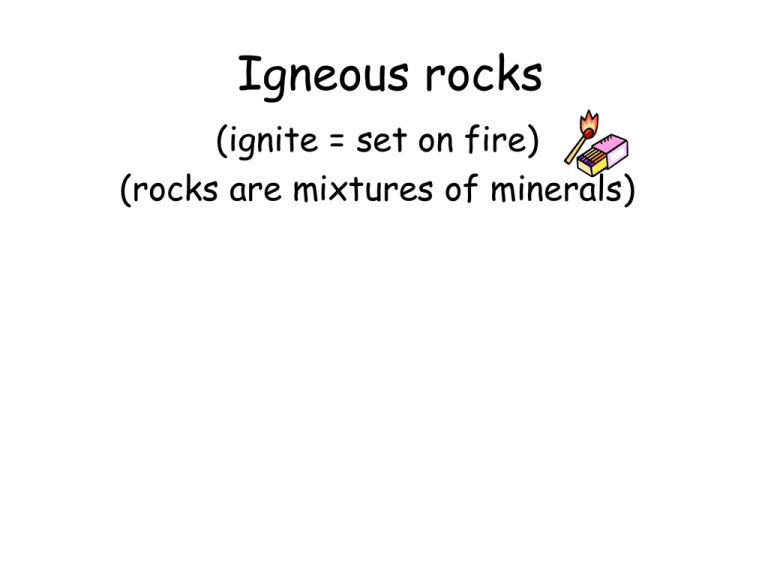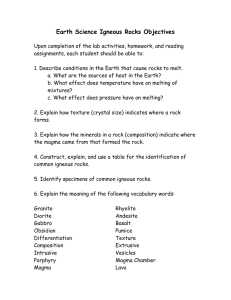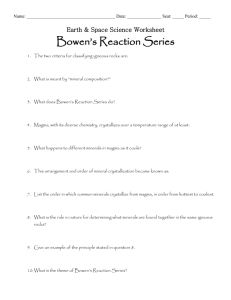Igneous rocks (ignite = set on fire) (rocks are mixtures of minerals)
advertisement

Igneous rocks (ignite = set on fire) (rocks are mixtures of minerals) How to form an igneous rock: (what to do to a mixture of minerals) • • • • Heat the minerals until they melt into magma, then cool so the minerals will again crystallize Where does heat to melt rock come from? • Compression from the original formation of the Earth • Radioactive elements inside the Earth • Compression from plate collisions • Friction from plate collisions Layer Details: Core - density = 10.8 g/cm3; 16% of Earth’s volume; 31.5% of Earth’s mass; mostly iron and nickel A. Inner core - solid - 2,600 km diameter B. Outer core - liquid - 2,200 km thick Mantle - half as dense as core; 82% of Earth’s volume; 68% of Earth’s mass (Layers continued): • Asthenosphere - upper part of mantle; 200 km thick; 65-100 km below surface; plastic • Lithosphere - 65-100 km thick; rigid rock Differentiation (= becoming different) Imaginary Field Trip to Foundry ! • Felsic (feldspar & silica) = light color, low density, low melting temperature. These float to top of magma chamber. • Mafic ( magnesium & iron (Fe)) = dark, dense, high melting temperature. These sink to bottom of magma chamber. So, because of differentiation, different igneous rocks have different compositions! (They are made of different minerals.) • 1.) Light-colored, low density, low melting temperature minerals, • 2.) Medium minerals, or • 3.) Dark, dense, high melting temperature minerals. Texture • For Rocks - texture is judged by sight, not touch! • Texture refers to crystal size. • Magma that cools slowly underground forms big crystals and course texture. • Lava that cools quickly at the surface forms crystals too small to see without a lens and has fine texture. Intrusive v.s. Extrusive • Intrusive igneous rocks cooled slowly underground and have big, visible crystals (coarse texture). • Extrusive igneous rocks cooled quickly and have small crystals that you would need a lens to see (fine texture). Simplified Version: Composition Texture Rock Names Extrusive Exceptions: Porphyry • If magma starts cooling slowly underground, but erupts to the surface before completely solidifying and finishes cooling quickly at the surface, the resulting rock will have large crystals surrounded by smaller crystals. This texture is a porphyry. Andesite is often a porphyry. Glassy Texture • If lava cools instantly, crystals do not have time to form and volcanic glass results. This rock is named obsidian. • Native Americans often made arrowheads out of obsidian. Vesicles = Bubbles • If the lava had lots of dissolved gasses, it will bubble while cooling quickly, and the resulting rock will have a vesicular texture.






